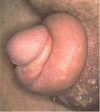Non-traumatic urologic emergencies in men: a clinical review
- PMID: 20046251
- PMCID: PMC2791735
Non-traumatic urologic emergencies in men: a clinical review
Abstract
Although true urologic emergencies are extremely rare, they are a vital part of any emergency physician's (EP) knowledge base, as delays in treatment lead to permanent damage. The four urologic emergencies discussed are priapism, paraphimosis, testicular torsion, and Fournier's gangrene. An overview is given for each, including causes, pathophysiology, diagnosis, treatment, and new developments. The focus for priapism is on diagnosis and distinguishing high-flow from low-flow forms, as the latter requires emergent treatment. For paraphimosis, we describe various methods of relieving the stricture, from manual reduction to surgery in extreme cases. For testicular torsion, the most important factor in salvaging the testicle is decreasing time to treatment. This is accomplished through experience and understanding which signs and symptoms strongly suggest it, so that time-consuming tests are avoided. Lastly, Fournier's gangrene is potentially fatal. While aggressive medical and surgical therapy will improve chances of survival and outcome, it is vital for the emergency department (ED) physician to diagnose Fournier's. It often presents in the elderly, immunocompromised, or those with depressed mental status. The goal of this paper is to arm EPs with information to recognize urological emergencies and intervene quickly to preserve tissue, fertility, and life.
Figures




Similar articles
-
Urologic emergencies. Trauma injuries and conditions affecting the penis, scrotum, and testicles.Postgrad Med. 1996 Oct;100(4):187-90, 193-4, 199-200. doi: 10.3810/pgm.1996.10.101. Postgrad Med. 1996. PMID: 8858091 Review.
-
Urologic Emergencies.Surg Clin North Am. 2016 Jun;96(3):407-24. doi: 10.1016/j.suc.2016.02.001. Surg Clin North Am. 2016. PMID: 27261785 Review.
-
Fournier's gangrene. A clinical review.Arch Ital Urol Androl. 2016 Oct 5;88(3):157-164. doi: 10.4081/aiua.2016.3.157. Arch Ital Urol Androl. 2016. PMID: 27711086 Review.
-
Urologic Emergencies.Med Clin North Am. 2018 Mar;102(2):373-385. doi: 10.1016/j.mcna.2017.10.013. Epub 2017 Dec 20. Med Clin North Am. 2018. PMID: 29406065 Review.
-
Fournier's gangrene: a urologic emergency.Am Fam Physician. 1995 Nov 1;52(6):1821-5. Am Fam Physician. 1995. PMID: 7484692 Review.
Cited by
-
The top 100 cited articles on urological emergencies: A bibliometric analysis.Turk J Urol. 2018 May;44(3):239-250. doi: 10.5152/tud.2017.82609. Epub 2017 Dec 20. Turk J Urol. 2018. PMID: 29733798 Free PMC article.
-
Recurrent priapism from therapeutic quetiapine.West J Emerg Med. 2014 Feb;15(1):114-6. doi: 10.5811/westjem.2013.8.18548. West J Emerg Med. 2014. PMID: 24578777 Free PMC article.
-
Design and Implementation of a Low-Cost Priapism Reduction Task Trainer.J Educ Teach Emerg Med. 2021 Jan 15;6(1):I1-I9. doi: 10.21980/J8K64F. eCollection 2021 Jan. J Educ Teach Emerg Med. 2021. PMID: 37465537 Free PMC article.
-
Spectrum of urological cases in a West African Tertiary Hospital.Ann Afr Med. 2021 Jan-Mar;20(1):14-18. doi: 10.4103/aam.aam_7_20. Ann Afr Med. 2021. PMID: 33727506 Free PMC article.
-
Inhibition of NADPH oxidase alleviates germ cell apoptosis and ER stress during testicular ischemia reperfusion injury.Saudi J Biol Sci. 2020 Aug;27(8):2174-2184. doi: 10.1016/j.sjbs.2020.04.024. Epub 2020 Apr 21. Saudi J Biol Sci. 2020. PMID: 32714044 Free PMC article.
References
-
- Rosenstein D, McAninch J. Urologic Emergencies. Med Clin North Am. 2004;88:495–518. - PubMed
-
- Burnett AL, Bivalacqua TJ. Priapsim Current Principles and Practice. Urol Clin North Am. 2007;34:631–42. - PubMed
-
- Wagner MJ. PEER VII: Physician’s evaluation and educational review in emergency medicine. ACEP; 2006. (revised 2007).
-
- Numan F, Cantasdemir M, Ozbayrak M, et al. Posttraumatic Nonischemic Priapism Treated with Autologous Blood Clot Embolization. J Sex Med. 2008;5:173–9. - PubMed
-
- Samm BJ, Dmochowski RR. Urologic emergencies. Postgrad Med. 1996;100:187–200. - PubMed

